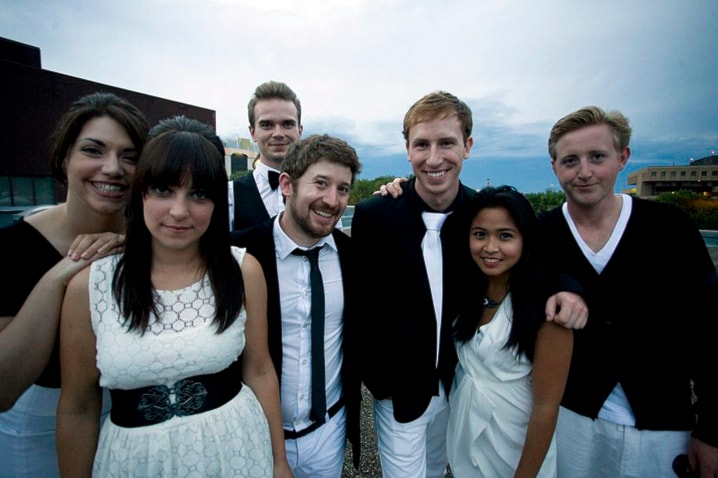Bower Ponds, the rail-turned-pedestrian bridge, Ross Street and Little Gaetz, City Hall Park, Knox Presbyterian Church, Central Middle School. ...
Watching Year After Year, the movie, is like playing connect-the-dots on a map of Red Deer. Virtually every outdoor scene contains a familiar vista as a group of city filmmakers shot local footage to bring their stage musical to cinematic life.
The 2 1/2-hour film that debuted Sunday night at the Carnival Cinemas was based on a very successful all-original 2010 stage show presented by Ignition Theatre at the now defunct The Matchbox theatre.
The stage musical was written by Matt Grue, with music by Curtis Labelle, lyrics by Spenser Pasman and Stephanie Ridge.
This time out, producer Grue and director Dustin Clark wrote the screen story about seven friends and how they adjust — or in some cases don’t — to life in their late 20s.
As in the stage production, the movie’s plot unwinds over three years at the birthday celebrations of central character Bill, a struggling writer, who as the press material states “is paralyzed by expectations and fraught with fears about a seemingly bleak future.”
Unfortunately, the filmed version, does not work as well as the stage musical.
Since the cast and crew poured their hearts and souls into this project, they deserve an honest response — this over-long film needs serious trimming.
At most, it should be an hour and a half.
It starts and ends well, but is wordy, over earnest in the middle section, and could use more likable, relatable characters — as well as more humour.
While stage shows can be over-the-top and obvious, good movies are mostly about showing, not telling.
They are about a subtly raised eyebrow, the hurt in someone’s eye. The song My Love is Not Meant for You, for instance (sung by divorcing couple Rachel and Todd, played by Elena Porter and Chris W. Cook), would have been infinitely more touching if the camera had focused on the singers’ faces instead of their acrobatics on the gym floor.
But films are also about imagery.
And on the positive side, this project, made for an astonishingly low budget of $175,000 (mostly gifts in kind), contains some marvelously creative cinematography by director of photography Don Armstrong.
There’s the wonderful ticker tape and rice scene in a grocery aisle as Laura (Zina Lee) fantasizes about her wedding.
There are inventive music video-like scenes of photographer Hunter on a fashion shoot, with abstract shadows moving across a wall.
The film also contains a talented cast of singing actors and some decent, catchy music.
One of the best songs in Year After Year is delivered by the unhappily married Rachel and Todd. It plays like a spoof of the Summer Nights bleacher scene from Grease.
Another great spoken-word song is Manifesto.
The soon-to-be-wed Peter (Andrew McKenzie) performs it like a beat poem in response to rising wedding costs and his fiancée Laura’s bridezilla behaviour.
More of this kind of light-hearted mood is needed throughout the film, but instead we repeatedly hear depressive people making speeches about how their lives suck.
Bill, played by Joel Crichton, announces in a voice-over at the start that he sees his own birthday as a reoccurring tragedy.
Why?
His navel-gazing character, especially, needs to be more dimensionally drawn.
Viewers need to really understand why Bill is so unfulfilled and see what continues to make him so appealing to better adjusted friends, such as Kate (Sarah Hemphill).
Even Bill’s best friend Hunter, a successful photographer (played by Matthew Thiel), gets fed up with his negativity, telling him to get over himself: “I wish you’d stop acting like you’re some sort of walking metaphor for lost dreams,” said Hunter.
Amen to that, brother.
A lesson on how black humour and wit can be used to make even the most upsetting life experiences palatable and entertaining for audiences can be gleaned from the 2011 film 50/50, in which the likable protagonist struggles with a real potential tragedy — cancer.
Year After Year gets it right in the end, with flashbacks that finally help us understand why Bill is so cherished among his friends. It would have helped if we had glimpsed some of this warmth and caring earlier on.
As Grue said in his introduction to Sunday night’s screening, this version of Year After Year is not the last.
Hopefully there are still opportunities to tighten things up, edit out the dirge-like bits and play up the humour.
Since this project is already a colossally ambitious undertaking, a little more work on it would be worthwhile and might even pay off big time.
The movie is showing to the public from Nov. 1 to 7 at Red Deer’s Carnival Cinemas. (See if your street makes a cameo appearance.)
lmichelin@www.reddeeradvocate.com
